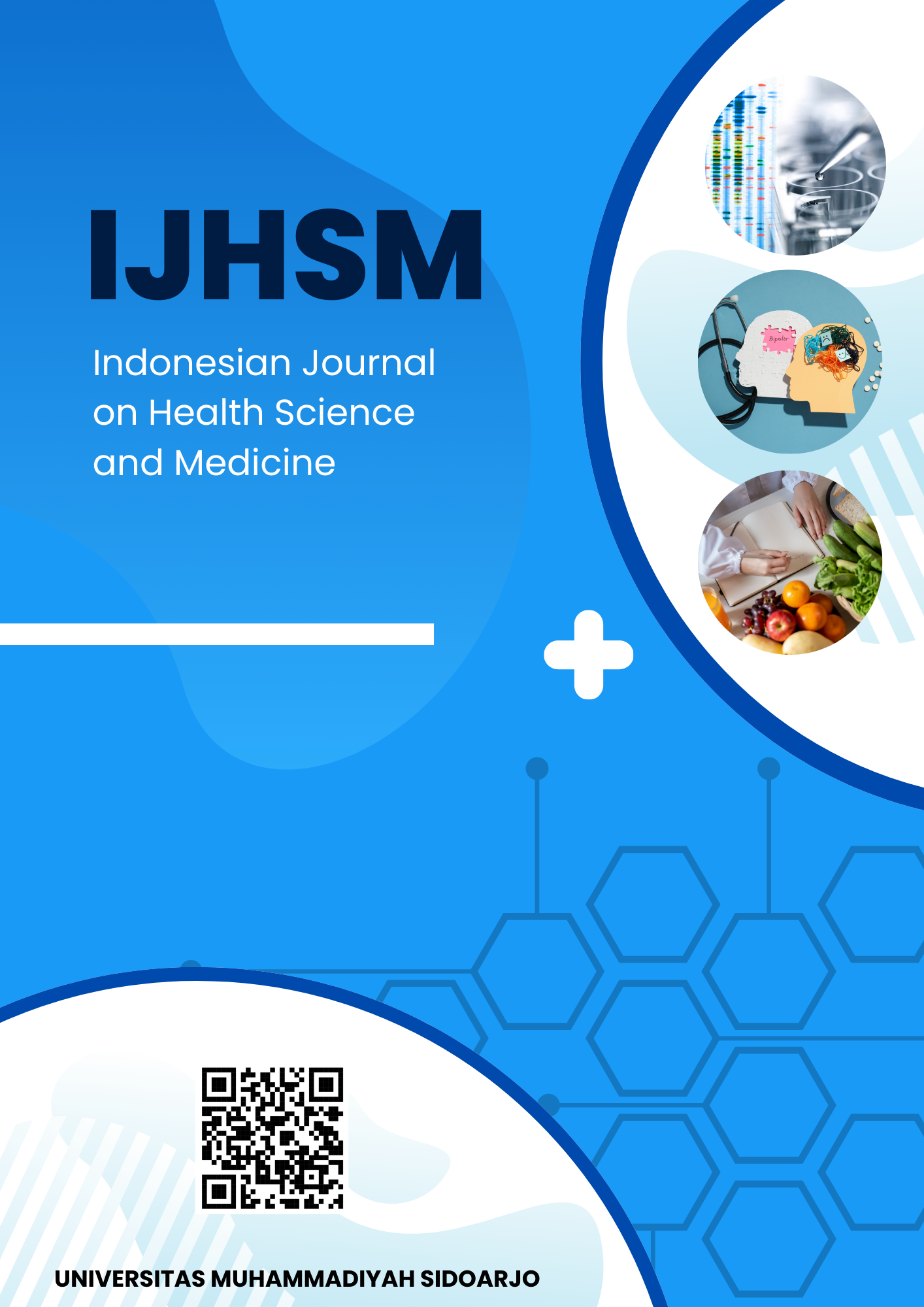Immunoglobulin Variations and Risk Factors Linked to Pregnancy Loss
DOI:
https://doi.org/10.21070/ijhsm.v2i1.166Keywords:
Toxoplasma gondii, Immunoglobulins, Abortion, Risk Factors, SeroprevalenceAbstract
Objectives: To investigate the immunological changes, demographic risk factors, and potential correlations between Toxoplasma gondii infection and abortion incidence. Methods: A comprehensive cross-sectional study was conducted on 22 participants, analyzing IgG and IgM antibody levels, demographic characteristics, and histological changes across different age groups. Immunological markers, residence patterns, cat contact, and meat consumption were evaluated using statistical analyses. Results: Significant immunological variations were observed: IgG levels escalated from 51.25 IU/ML (healthy individuals) to 310.25 IU/ML (two abortion history), IgM levels demonstrated complex fluctuations across abortion categories, Undercooked meat consumption emerged as the most critical risk factor (OR: 2.5, p=0.001), Cat contact (OR: 1.6, p=0.016) and rural residence (OR: 1.1, p=0.012) were secondary risk factors, Age group 26-30 years demonstrated the highest pregnancy and abortion variability. Conclusions: Toxoplasma gondii infection demonstrates complex immunological responses correlated with abortion history, with dietary and environmental factors significantly influencing infection risk. The study underscores the need for targeted screening and preventive strategies in high-risk populations.
Highlights:
-
IgG levels increase with abortion history; IgM shows variable patterns.
-
Undercooked meat, cat contact, and rural living raise infection risk.
-
Women aged 26–30 show highest variability in pregnancy outcomes.
Keywords: Toxoplasma gondii, Immunoglobulins, Abortion, Risk Factors, Seroprevalence
References
[1] J. P. Dubey, Toxoplasmosis of Animals and Humans, 2nd ed. Beltsville, Maryland, USA: CRC Press, 2010.
[2] P. R. Torgerson and P. Mastroiacovo, “Global Burden of Congenital Toxoplasmosis: Systematic Review,” Bulletin of the World Health Organization, vol. 91, pp. 501–508, 2013.
[3] H. Fricker-Hidalgo et al., “Toxoplasma Seroconversion With Negative or Transient Immunoglobulin M in Pregnant Women: Myth or Reality? A French Multicenter Retrospective Study,” Journal of Clinical Microbiology, vol. 51, no. 6, pp. 2103–2111, 2013.
[4] M. D. Sarkar, B. Anuradha, N. Sharma, and R. N. Roy, “Seropositivity of Toxoplasmosis in Antenatal Women With Bad Obstetric History in a Tertiary-Care Hospital of Andhra Pradesh, India,” Journal of Health, Population and Nutrition, vol. 30, no. 1, pp. 87–92, 2012.
[5] N. Kumari, N. Morris, and R. Dutta, “Is Screening of TORCH Worthwhile in Women With Bad Obstetric History: An Observation From Eastern Nepal,” Journal of Health, Population and Nutrition, vol. 29, no. 1, pp. 77–80, 2011.
[6] P. Yasodhara, B. A. Ramalakshmi, V. Lakshmi, and T. P. Krishna, “Socioeconomic Status and Prevalence of Toxoplasmosis During Pregnancy,” Indian Journal of Medical Microbiology, vol. 22, no. 4, pp. 241–243, 2004.
[7] R. McLeod and J. S. Remington, “Toxoplasmosis (Toxoplasma Gondii),” in Nelson Textbook of Pediatrics, R. E. Behrman, R. M. Kliegman, and H. B. Jenson, Eds., 16th ed., Philadelphia, PA: WB Saunders, 2000, pp. 1054–1062.
[8] H. K. El Deeb, H. Salah-Eldin, and S. Khodeer, “Prevalence of Toxoplasma Gondii Infection in Antenatal Population in Menoufia Governorate, Egypt,” Acta Tropica, vol. 124, no. 3, pp. 185–191, 2012.
[9] J. J. Schiesselman, Case-Control Studies: Design, Conduct, Analysis, New York, NY: Oxford University Press, 1982.
[10] A. E. Tammam et al., “Seroepidemiology of Toxoplasma Gondii Infection in Women With First Trimester Spontaneous Miscarriage in Qena Governorate, Egypt,” Journal of Clinical and Diagnostic Research, vol. 7, no. 12, pp. 2870–2873, 2013.
[11] S. Chintapally, “Seroprevalence of Toxoplasmosis in Antenatal Women With Bad Obstetric History,” Tropical Parasitology, vol. 3, no. 1, pp. 62–66, 2013.
[12] S. Senthamarai et al., “Seroprevalence of Toxoplasmosis in Pregnant Women With Bad Obstetric History in a Tertiary Care Hospital, Kanchipuram—A Pilot Study,” Disease, vol. 3, no. 1, pp. 29–32, 2013.
[13] A. H. Hussein, A. E. Ali, M. H. Saleh, I. M. Nagaty, and A. Y. Rezk, “Seroprevalence of Toxoplasma Infection in Qualyobia Governorate, Egypt,” Journal of the Egyptian Society of Parasitology, vol. 31, no. 2, pp. 355–363, 2001.
[14] E. Zemene et al., “Seroprevalence of Toxoplasma Gondii and Associated Risk Factors Among Pregnant Women in Jimma Town, South Western Ethiopia,” BMC Infectious Diseases, vol. 12, p. 337, 2012.
[15] S. M. Spalding, M. R. Amendoeira, C. H. Klein, and L. C. Ribeiro, “Serological Screening and Toxoplasmosis Exposure Factors Among Pregnant Women in South of Brazil,” Revista da Sociedade Brasileira de Medicina Tropical, vol. 38, no. 3, pp. 173–177, 2005.
[16] A. Malarvizhi et al., “Seroprevalence of Toxoplasma Gondii in Pregnant Women,” Journal of Public Health and Epidemiology, vol. 4, no. 7, pp. 170–177, 2012.
[17] N. Siddiqui, F. Shujatullah, H. M. Khan, T. Rabbani, and P. A. Khan, “Socioeconomic Status and Prevalence of Toxoplasmosis in Pregnant Women With Bad Obstetric History,” Journal of Immunology and Vaccine Technology, vol. 1, no. 1, pp. 101–103, 2014.
[18] X. L. Li et al., “A Meta-Analysis on Risks of Adverse Pregnancy Outcomes in Toxoplasma Gondii Infection,” PLoS One, vol. 9, no. 5, e97775, 2014.
[19] G. O. Ajayi and S. A. Omilabu, “Prenatal Diagnosis of Cytomegalovirus (CMV), Rubella, Toxoplasmosis, Varicella, Parvovirus, Herpes Simplex and Syphilis: The Lagos Programme Experience,” Clinical and Experimental Obstetrics & Gynecology, vol. 37, no. 1, pp. 37–38, 2010.
[20] M. Cortina-Borja et al., “Prenatal Treatment for Serious Neurological Sequelae of Congenital Toxoplasmosis: An Observational Prospective Cohort Study,” PLoS Medicine, vol. 7, no. 10, e1000351, 2010.
[21] Q. Liu et al., “Toxoplasma Gondii Infection in Pregnant Women in China,” Transactions of the Royal Society of Tropical Medicine and Hygiene, vol. 103, no. 2, pp. 162–166, 2009.
[22] T. K. Mohammed, “Seroprevalence of Toxoplasma Gondii Among Pregnant Women in Baghdad City,” Iraqi Academic Scientific Journal, vol. 24, pp. 21–28, 2011.
Downloads
Published
How to Cite
Issue
Section
License
Copyright (c) 2025 Mohammed A.Ameer Haraj, Mohammed Obaid Al-Mansoori, Rajwan Jawad Al-Obaidi

This work is licensed under a Creative Commons Attribution 4.0 International License.





